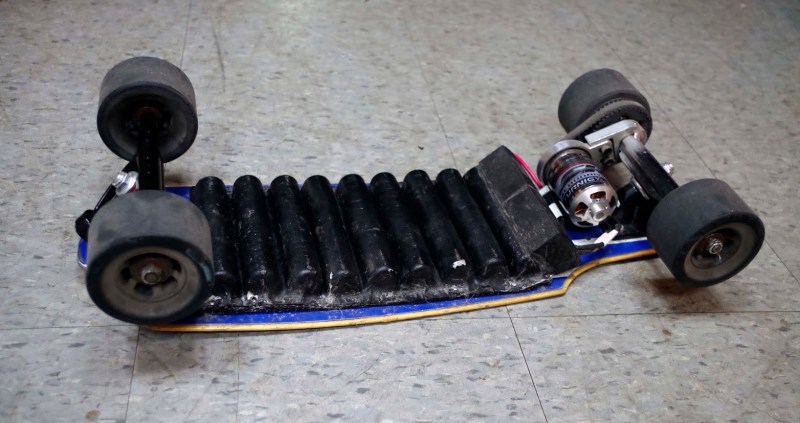DIY electric longboards are a ton of fun to build and ride (we’ve featured several builds before). Most boards have batteries strapped to the bottom of a rigid board, or they have battery packs near each truck so the board can still flex. Instead of going with either of these designs, [Ben] created a custom battery pack design that’s able to flex with the board.
[Ben]’s pack is made up of A123 26650 cells nestled in his custom-fabricated enclosure. [Ben] designed his pack in CAD and used a CNC machine to create a foam mold. He used the mold to do a fiberglass layup, vacuum-bagged it, and left it to cure. Since the fiberglass bonded really well to the foam, [Ben] used acetone to dissolve the foam while leaving his fiberglass layup intact.
 [Ben]’s pack fits 18 cells which he soldered together with some flexible copper grounding wire. The top side of the enclosure is covered with a layer of insulating rubber, and the rim is covered with a soft foam to form a gasket against the board. As you can see, the pack bends really well with the board, and it doesn’t look like [Ben] has had any issues with his design so far. Check out [Ben]’s blog for more info and for more details on the overall design of his board.
[Ben]’s pack fits 18 cells which he soldered together with some flexible copper grounding wire. The top side of the enclosure is covered with a layer of insulating rubber, and the rim is covered with a soft foam to form a gasket against the board. As you can see, the pack bends really well with the board, and it doesn’t look like [Ben] has had any issues with his design so far. Check out [Ben]’s blog for more info and for more details on the overall design of his board.
















Great, no more grind on rails… but you don’t have to kick to go.
With that silliness out of me, I’m wondering if this technique can be used (or has already been used) in an electric car. I’m thinking this would well in placing batteries in the tires. Maybe with wireless power coils on the hubs to collect the power and deliver it to the rest of the vehicle.
What reason is there to put batteries in tires (or even wheels)? (other than for tire pressure warning systems, of course). That’s a pretty punishing place to put them (high g forces, shocks) and seriously complicates a host of other things, and for what purpose?. Increasing unsprung mass is also always a bad idea.
Wireless power transfer has unnecessary energy loss vs good old copper wire. Good luck transferring power in the kW range *efficiently* with that. Even when battery capacity is no longer an issue in EV, so yeah I am sure that adding more loss and heat is well worth it. Also it is not like there is any advantage of using wireless power in something that is fixed. A wiring harness is far superior.
Unsprung weight.
Unfortunatly with the degrading of the infrastructure, such a car would have horrible handeling characteristics as there is now alot more mass to deal with when it hits a pothole or curbing. Things will break. This is also why hub motors dont really work in most vehicles.
Great build and could have a host of other uses, but I cringed when I saw the open motor – maybe mold a vented housing to keep the flying crud out of the windings?
Just too tricky, the battery and motor can easily be damaged and you’d never feel comfortable with this design in real use.